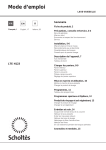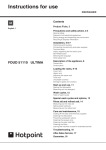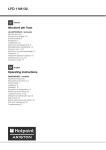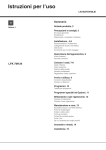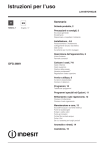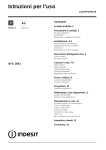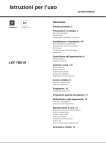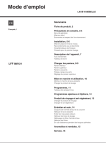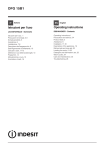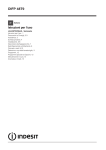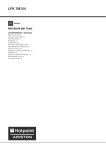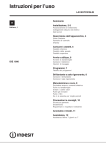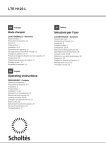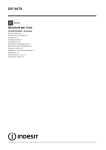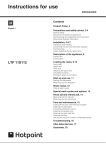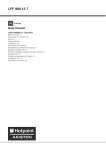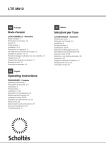Download Istruzioni per l`uso
Transcript
Istruzioni per l’uso LAVASTOVIGLIE IT Italiano, 1 EN English,15 Sommario Scheda prodotto, 2 Precauzioni e consigli, 3 Sicurezza generale Smaltimento Risparmiare e rispettare l’ambiente Installazione e Assistenza, 4-5 Posizionamento e livellamento Collegamenti idraulici ed elettrici Dati tecnici Avvertenze per il primo lavaggio Assistenza Descrizione dell’apparecchio, 6 Vista d’insieme Pannello comandi LTF 11T123 Caricare i cesti, 7-8 Cesto inferiore Cesto superiore Regolazione cesto superiore Terzo cesto* Avvio e utilizzo, 9 Avviare la lavastoviglie Caricare il detersivo Programmi, 10 Tabella dei programmi Programmi speciali ed Opzioni, 11 Brillantante e sale rigenerante, 12 Caricare il brillantante Caricare il sale rigenerante Manutenzione e cura, 13 Escludere acqua e corrente elettrica Pulire la lavastoviglie Evitare i cattivi odori Pulire gli irroratori Pulizia filtro entrata acqua Pulire i filtri Se ci si assenta per lunghi periodi Anomalie e rimedi, 14 Scheda prodotto IT Scheda prodotto Marchio HOTPOINT ARISTON Modello LTF 11T123 Capacità nominale in numero di coperti standard (1) 14 Classe di efficienza energetica su una scala da A+++ (bassi consumi) a D (alti consumi) A++ Consumo energetico annuo in kWh (2) 265 Consumo energetico del ciclo di lavaggio standard in kWh 0.93 Consumo di potenza nel modo spento in W 0.5 Consumo di potenza nel modo lasciato acceso in W 5.0 Consumo di acqua annuo in litri (3) 2800 Classe di efficacia di asciugatura su una scala da G (efficacia minima) ad A (efficacia massima) A Durata del programma per il ciclo di lavaggio standard in minuti 190 Durata del modo lasciato acceso in minuti 10 Rumore in dB(A) re 1 pW 43 Prodotto da incasso Si NOTE 1) L’informazione sull’etichetta e sulla scheda fanno riferimento al programma standard di lavaggio, questo programma è adatto per lavare stoviglie che presentano un grado di sporco normale ed è il programma più efficiente in termini di consumo combinato di energia ed acqua. Il ciclo standard corrisponde al ciclo ECO. 2) Consumo di energia basato su 280 cicli annui standard con acqua caricata fredda e sui consumi in modo di spento o di lasciato acceso dopo la fine ciclo. Il consumo effettivo dipende da come viene usato l’elettrodomestico. 3) Basato su 280 cicli di lavaggio standard. Il consumo effettivo dipende dalle modalità di utilizzo dell’apparecchio. 2 Precauzioni e consigli L’apparecchio è stato progettato e costruito in conformità alle norme internazionali di sicurezza. Queste avvertenze sono fornite per ragioni di sicurezza e devono essere lette attentamente. È importante conservare questo libretto per poterlo consultare in ogni momento. In caso di vendita, di cessione o di trasloco, assicurarsi che resti insieme all’apparecchio. Leggere attentamente le istruzioni: ci sono importanti informazioni sull’installazione, sull’uso e sulla sicurezza. Questo apparecchio è progettato per l’uso domestico o per applicazioni simili, ad esempio: - aree adibite a cucina per il personale in negozi, uffici ed altri ambienti di lavoro; - case coloniche; - utilizzo da parte di clienti in hotel, motel ed altri ambienti di tipo residenziale; - bed and breakfast. Sicurezza generale • Questo elettrodomestico non può venire usato da persone (bambini compresi) con ridotte capacità fisiche, sensoriali o mentali, o mancanza di esperienza e conoscenza, a meno che non venga loro fornita supervisione o istruzioni riguardanti l’uso da una persona responsabile della loro sicurezza. • È necessaria la supervisione di un adulto per evitare che i bambini giochino con l’elettrodomestico. • L’apparecchio è stato concepito per un uso di tipo non professionale all’interno dell’abitazione. • L’apparecchio deve essere usato per il lavaggio delle stoviglie a uso domestico, solo da persone adulte e secondo le istruzioni riportate in questo libretto. • L’apparecchio non va installato all’aperto, nemmeno se lo spazio è riparato, perché è molto pericoloso lasciarlo esposto a pioggia e temporali. • Non toccare la lavastoviglie a piedi nudi. • Non staccare la spina dalla presa della corrente tirando il cavo, bensì afferrando la spina. • È necessario chiudere il rubinetto dell’acqua e staccare la spina dalla presa della corrente prima di effettuare operazioni di pulizia e manutenzione. • In caso di guasto, in nessun caso accedere ai meccanismi interni per tentare una riparazione. • Non appoggiarsi o sedersi sulla porta aperta: l’apparecchio potrebbe ribaltarsi. • La porta non deve essere tenuta nella posizione aperta perchè può rappresentare il pericolo di inciampare. • Tenere il detersivo e il brillantante fuori dalla portata dei bambini. • Gli imballaggi non sono giocattoli per bambini. Smaltimento • Smaltimento del materiale di imballaggio: attenersi alle norme locali, così gli imballaggi potranno essere riutilizzati. • La direttiva Europea 2012/19/EU sui rifiuti di apparecchiature elettriche ed elettroniche (RAEE), prevede che gli elettrodomestici non debbano essere smaltiti nel normale flusso dei rifiuti solidi urbani. Gli apparecchi dismessi devono essere raccolti separatamente per ottimizzare il tasso di recupero e riciclaggio dei materiali che li compongono e impedire potenziali danni per la salute e l’ambiente. Il simbolo del cestino barrato è riportato su tutti i prodotti per ricordare gli obblighi di raccolta separata. Per ulteriori informazioni, sulla corretta dismissione degli elettrodomestici, i detentori potranno rivolgersi al servizio pubblico preposto o ai rivenditori. Risparmiare e rispettare l’ambiente Risparmiare acqua ed energia • Avviare la lavastoviglie solo a pieno carico. In attesa che la macchina sia piena, prevenire i cattivi odori con il ciclo Ammollo (vedi Programmi). • Selezionare un programma adatto al tipo di stoviglie e al grado di sporco consultando la Tabella dei programmi: - per stoviglie normalmente sporche utilizzare il programma Eco, che garantisce bassi consumi energetici e di acqua. - se il carico è ridotto attivare l’opzione Mezzo carico* (vedi Avvio e utilizzo). • Se il proprio contratto di erogazione dell’energia elettrica prevede fasce orarie di risparmio energetico, effettuare i lavaggi negli orari a tariffa ridotta. L’opzione Partenza Ritardata* (vedi Avvio e utilizzo) può aiutare a organizzare i lavaggi in tal senso. Detersivi senza fosfati, senza cloro e contenenti enzimi • Si consiglia vivamente di usare i detersivi senza fosfati e senza cloro che sono i più indicati per la tutela dell’ambiente. • Gli enzimi sviluppano un’azione particolarmente efficace con temperature prossime ai 50°C, per cui con i detersivi con enzimi si possono impostare lavaggi a basse temperature e ottenere gli stessi risultati che si avrebbero a 65°C. • Dosare bene il detersivo in base alle indicazioni del produttore, alla durezza dell’acqua, al grado di sporco e alla quantità di stoviglie per evitare sprechi. Pur biodegradabili, i detersivi contengono elementi che alterano l’equilibrio della natura. * Presente solo su alcuni modelli. 3 IT Installazione e Assistenza IT In caso di trasloco tenere l’apparecchio in posizione verticale; se fosse necessario, inclinarlo sul lato posteriore. Fare attenzione che nel tubo non ci siano né pieghe né strozzature. Posizionamento e livellamento Collegamento del tubo di scarico dell’acqua 1. Disimballare l’apparecchio e controllare che non abbia subìto danni durante il trasporto. Se fosse danneggiato non collegarlo e contattare il rivenditore. 2. Sistemare la lavastoviglie facendo aderire i fianchi o lo schienale ai mobili adiacenti o alla parete. L’apparecchio può anche essere incassato sotto a un piano di lavoro continuo* (vedi foglio di Montaggio). Collegare il tubo di scarico, senza piegarlo, a una conduttura di scarico con diametro minimo di 4 cm. Il tubo di scarico deve essere ad un’altezza compresa tra 40 e 80 cm. dal pavimento o piano d’appoggio della lavastoviglie (A). 3. Posizionare la lavastoviglie su un pavimento piano e rigido. Compensare le irregolarità svitando o avvitando i piedini anteriori finché l’apparecchio non sia orizzontale. Un accurato livellamento dà stabilità ed evita vibrazioni, rumori e spostamenti. 4*. Per regolare l’altezza del piedino posteriore, agire sulla boccola esagonale di colore rosso presente nella parte inferiore, frontale, centrale della lavastoviglie, con una chiave a bocca esagonale apertura 8 mm., girando in senso orario per aumentare l’altezza e in senso antiorario per diminuirla. (vedere foglio istruzioni incasso allegato alla documentazione) Collegamenti idraulici ed elettrici L’adattamento degli impianti elettrici e idraulici per l’installazione deve essere eseguito solo da personale qualificato. La lavastoviglie non deve appoggiare sui tubi o sul cavo di alimentazione elettrica. L’apparecchio deve essere collegato alla rete di distribuzione dell’acqua utilizzando tubi nuovi. Non riutilizzare i vecchi tubi. I tubi di carico e di scarico dell’acqua e il cavo di alimentazione elettrica possono essere orientati verso destra o sinistra per consentire la migliore installazione. Collegamento del tubo di carico dell’acqua • A una presa d’acqua fredda: avvitare bene il tubo di carico a un rubinetto con bocca filettata da 3/4 gas; prima di avvitare, far scorrere l’acqua finché non sia limpida affinché le eventuali impurità non intasino l’apparecchio. • A una presa d’acqua calda: nel caso di impianto centralizzato di termosifoni, la lavastoviglie può essere alimentata con acqua calda di rete purché non superi la temperatura di 60°C. Avvitare il tubo al rubinetto come descritto per la presa d’acqua fredda. Se la lunghezza del tubo di carico non è sufficiente, rivolgersi a un negozio specializzato o a un tecnico autorizzato (vedi Assistenza). La pressione dell’acqua deve essere compresa nei valori riportati dalla tabella Dati tecnici (vedi a lato). 4 Prima di collegare il tubo di scarico dell’acqua al sifone del lavandino, rimuovere il tappo di plastica (B). Sicurezza antiallagamento Per garantire che non si generino allagamenti, la lavastoviglie: - è dotata di un sistema che interrompe l’ingresso dell’acqua nel caso di anomalie o di perdite dall’interno. Alcuni modelli sono dotati di un dispositivo supplementare di sicurezza New Acqua Stop*, che garantisce l’antiallagamento anche in caso di rottura del tubo di alimentazione. ATTENZIONE: TENSIONE PERICOLOSA! Il tubo di carico dell’acqua, non deve in nessun caso, essere tagliato in quanto contiene parti sotto tensione. Collegamento elettrico Prima di inserire la spina nella presa della corrente, accertarsi che: • la presa abbia la messa a terra e sia a norma di legge; • la presa sia in grado di sopportare il carico massimo di potenza della macchina, indicato nella targhetta caratteristiche sulla controporta (vedi capitolo Descrizione della lavastoviglie); • la tensione di alimentazione sia compresa nei valori indicati nella targhetta caratteristiche sulla controporta; • la presa sia compatibile con la spina dell’apparecchio. In caso contrario richiedere la sostituzione della spina a un tecnico autorizzato (vedi Assistenza); non usare prolunghe o prese multiple. Ad apparecchio installato, il cavo di alimentazione elettrica e la presa della corrente devono essere facilmente raggiungibili. Il cavo non deve subire piegature o compressioni. Se il cavo di alimentazione è danneggiato, deve essere sostituito dal costruttore o dal suo Servizio di Assistenza Tecnica, in modo da prevenire ogni rischio. (Vedi Assistenza) L’Azienda declina ogni responsabilità qualora queste norme non vengano rispettate. Assistenza Striscia anticondensa* Prima di contattare l’Assistenza: Dopo aver incassato la lavastoviglie aprire la porta e incollare la striscia adesiva trasparente sotto al ripiano in legno per proteggerlo dalla eventuale condensa. Dati Tecnici Capacità Larghezza cm. 59,5 Altezza cm. 82 Profondità cm. 57 14 coperti standard Pressione acqua alimentazione 0,05 ÷ 1MPa (0.5 ÷ 10 bar) 7,25 – 145 psi Tensione di alimentazione vedi targhetta caratteristiche Potenza totale assorbita vedi targhetta caratteristiche Fusibile vedi targhetta caratteristiche Dimensioni Questa apparecchiatura è conforme alle seguenti Direttive Comunitarie: -2006/95/EC (Bassa Tensione) -2004/108/EC (Compatibilità Elettromagnetica) -2009/125/EC (Comm. Reg. 1016/2010) (Ecodesign) -97/17/EC (Etichettatura) -2012/19/EU (RAEE) Avvertenze per il primo lavaggio Dopo l’installazione, rimuovere i tamponi posizionati sui cesti e gli elastici di trattenimento sul cesto superiore (dove presenti). Immediatamente prima del primo lavaggio, riempire completamente d’acqua il serbatoio del sale e solo dopo aggiungere circa 1 Kg di sale (vedi capitolo Brillantante e sale rigenerante): è normale che l’acqua trabocchi. Selezionare il livello di durezza dell’acqua (vedi tabella capitolo Brillantante e sale rigenerante). Dopo il caricamento del sale la spia MANCANZA SALE* si spegne. Il mancato riempimento del contenitore del sale, può provocare il danneggiamento del dolcificatore dell’acqua e dell’elemento riscaldante. La macchina, è dotata di segnali acustici/toni (secondo il modello d lavastoviglie) che avvisano dell’avvenuto comando: accensione, fine ciclo ecc.. I simboli/spie/led luminosi presenti sul pannello comandi/ display, possono variare di colore, pulsare o essere a luce fissa. (secondo il modello di lavastoviglie). Il display, visualizza informazioni utili relative al tipo di ciclo impostato, alla fase di lavaggio/asciugatura, al tempo residuo, alla temperatura ecc... ecc... IT • Verificare se l’anomalia può essere risolta da soli (vedi Anomalie e Rimedi). • Riavviare il programma per controllare se l’inconveniente è stato ovviato. • In caso negativo, contattare il Servizio Assistenza Tecnica Autorizzato. Non ricorrere mai a tecnici non autorizzati. Comunicare: • il tipo di anomalia; • il modello della macchina (Mod.); • il numero di serie (S/N). Queste informazioni si trovano sulla targhetta caratteristiche posta sull’apparecchio (vedi Descrizione dell’apparecchio). Assistenza Attiva 7 giorni su 7 Se nasce il bisogno di intervento chiamare il Numero Unico Nazionale 199.199.199*. Un operatore sarà a completa disposizione per fissare un appuntamento con Centro Assistenza Tecnico autorizzato più vicino al luogo da cui si chiama. È attivo 7 giorni su 7, sabato e domenica compresi, e non lascia mai inascoltata una richiesta. * Al costo di 14,25 centesimi di Euro al minuto (iva inclusa) dal Lun. al Ven. dalle 08:00 alle 18:30, il Sab. dalle 08:00 alle 13:00 e di 5,58 centesimi di Euro al minuto (iva inclusa) dal Lun. al Ven. dalle 18:30 alle 08:00, il Sab. dalle 13:00 alle 08:00 e i giorni festivi, per chi chiama dal telefono fisso. Per chi chiama da radiomobile le tariffe sono legate al piano tariffario dell’operatore telefonico utilizzato. Le suddette tariffe potrebbero essere soggette a variazione da parte dell’operatore telefonico; per maggiori informazioni consultare il sito www.aristonchannel.com. * Presente solo su alcuni modelli. 5 Descrizione dell’apparecchio IT Vista d’insieme 1. Cestello superiore 2. Irroratore superiore 3.Ribaltine 4. Regolatore altezza cestello 5. Terzo cesto* 6. Cestello inferiore 7. Irroratore inferiore 8. Filtro lavaggio 9. Serbatoio sale 10. Vaschette detersivo, serbatoio brillantante e dispositivo Active Oxigen* 11. Targhetta caratteristiche 12. Pannello comandi*** Pannello comandi Tasto e Spia Pastiglie multifunzione Tasto Selezione Programma Tasto e spia On-Off/Reset Spia Sale Spia Brillantante Indicatore luminoso numero programma e tempo residuo Tasto Partenza Ritardata Tasto e Spia Extra Asciugatura Spie selezione Tasto Zone Wash cesti Zone Wash Spia Partenza Ritardata *** Solo sui modelli ad incasso totale * Presente solo su alcuni modelli. Il numero e il tipo di programmi ed opzioni variano in base al modello di lavastoviglie. 6 Tasto e Spia Short Time Caricare i cesti Suggerimenti Prima di caricare i cesti, eliminare dalle stoviglie i residui di cibo e vuotare bicchieri e i contenitori dei liquidi rimasti. Non è necessario un risciacquo preventivo sotto acqua corrente. Sistemare le stoviglie in modo che siano ben ferme e non si ribaltino, i contenitori siano disposti con l’apertura rivolta in basso e le parti concave o convesse in posizione obliqua, per permettere all’acqua di raggiungere tutte le superfici e di defluire. Fate attenzione che coperchi, manici, padelle e vassoi non impediscano la rotazione degli irroratori. Disporre gli oggetti piccoli nel cestino delle posate. Le stoviglie in plastica e le padelle in antiaderente, tendono a trattenere maggiormente le gocce d’ acqua e quindi il loro grado di asciugatura risulterà inferiore a quello delle stoviglie in ceramica o acciaio. Gli oggetti leggeri (come i recipienti in plastica) devono essere preferibilmente posizionati sul cesto superiore e disposti in modo da non potersi muovere. Dopo aver caricato, assicurarsi che gli irroratori ruotino liberamente. Alcuni modelli di lavastoviglie, dispongono di settori reclinabili*, gli stessi si possono usare in posizione verticale per la sistemazione dei piatti oppure in posizione orizzontale (abbassati) per poter caricare più agevolmente pentole e insalatiere. Cesto superiore Caricare stoviglie delicate e leggere: bicchieri, tazze, piattini, insalatiere basse. Cesto inferiore Il cesto inferiore può contenere pentole, coperchi, piatti, insalatiere, posate ecc... Piatti e coperchi grandi vanno sistemati di preferenza ai lati del cesto. Alcuni modelli di lavastoviglie, dispongono di settori reclinabili*, utilizzabili in posizione verticale per sistemare piattini da thè o dessert o abbassati per caricare ciotole e contenitori per alimenti. Ribaltine a posizione variabile* Le ribaltine laterali sono posizionabili su tre altezze differenti per ottimizzare la disposizione delle stoviglie nello spazio del cesto. E’ consigliabile disporre le stoviglie molto sporche nel cesto inferiore poichè in questo settore i getti d’acqua sono più energici e permettono di ottenere migliori prestazioni di lavaggio. *Presente I calici possono essere posizionati stabilmente sulle ribaltine inserendo lo stelo del bicchiere nelle apposite asole. solo in alcuni modelli e variabili per numero e posizione. 7 IT IT Il cesto superiore è regolabile in altezza a seconda della necessità: in posizione alta quando nel cesto inferiore si vogliono sistemare stoviglie ingombranti; in posizione bassa, in modo da sfruttare gli spazi delle ribaltine o dei reclinabili creando più spazio verso l’alto. La geometria del cesto, permette di disporre nella zona centrale anche piccole stoviglie come tazzine da caffè. Regolare l’altezza del cesto superiore Per agevolare la sistemazione delle stoviglie, è possibile sistemare il cesto superiore in posizione alta o bassa. E’ preferibile regolare l’altezza del cesto superiore a CESTO VUOTO. Non sollevare o abbassare MAI il cesto su un solo lato. Il terzo cesto è dotato di due vassoi laterali scorrevoli che permettono un miglior sfruttamento in altezza dello spazio sottostante. Se il cesto è dotato di Lift-Up* (vedi figura), sollevare il cesto afferrandolo ai lati e muovere verso l’alto. Per tornare nella posizione bassa, premere le leve (A) ai lati del cesto ed accompagnare la discesa verso il basso. Non è possibile utilizzare il cesto superiore in posizione alta e con le ribaltine chiuse in verticale. Terzo cesto Il terzo cesto è adibito alla disposizione delle posate. Sistemare le posate come mostrato in figura. Stoviglie non idonee • Posate e stoviglie di legno. • Bicchieri decorati delicati, stoviglie di artigianato artistico e di antiquariato. Le loro decorazioni non sono resistenti. • Parti in materiale sintetico non resistenti alla temperatura. • Stoviglie di rame e stagno. • Stoviglie sporche di cenere, cera, grasso lubrificante o inchiostro. Le decorazioni su vetro, i pezzi di alluminio e argento durante il lavaggio possono tendere a cambiare colore ed a sbiancarsi. Anche alcuni tipi di vetro (per es. oggetti di cristallo) dopo molti lavaggi possono diventare opachi. Danni al vetro ed alle stoviglie Cause: “I coltelli e gli utensili con bordi affilati devono essere sistemati con le lame rivolte verso il basso.” La disposizione separata delle posate, ne facilita il prelievo dopo il lavaggio e ne migliora le prestazioni di lavaggio e asciugatura. 8 • Tipo di vetro e procedimento di produzione del vetro. • Composizione chimica del detersivo. • Temperatura dell’acqua del programma di risciacquo. Consiglio: • Utilizzare solo bicchieri e porcellana garantiti dal produttore come resistenti al lavaggio in lavastoviglie. • Usare detersivo delicato per stoviglie. • Estrarre bicchieri e posate dalla lavastoviglie al più presto possibile dopo la fine del programma. Avvio e utilizzo Avviare la lavastoviglie 1. Aprire il rubinetto dell’acqua. 2. Aprire la porta e premere il tasto ON-OFF: le spie ON/OFF, opzioni e il display si illuminano. 3. Dosare il detersivo. (vedi a lato). 4. Caricare i cesti (vedi Caricare i cesti). 5. Selezionare il programma in base alle stoviglie e al loro grado di sporco (vedi tabella dei programmi) premendo il tasto P. 6. Selezionare le opzioni di lavaggio*. (vedi Progr. speciali ed Opzioni). 7. Avviare chiudendo la porta. 8. La fine del programma è segnalata da segnali acustici e lampeggia il numero del programma sul display. Aprire la porta, spegnere l’apparecchio premendo il tasto ON-OFF, chiudere il rubinetto dell’acqua e staccare la spina dalla presa di corrente. 9. Aspettare alcuni minuti prima di togliere le stoviglie, per evitare di scottarsi. Scaricare i cestelli iniziando da quello inferiore. - Per ridurre il consumo di energia elettrica, in alcune condizioni di NON utilizzo prolungato, la macchina si spegne automaticamente. Caricare il detersivo Il buon risultato del lavaggio dipende anche dal corretto dosaggio del detersivo, eccedendo non si lava in modo più efficace e si inquina l’ambiente. A seconda del grado di sporco, il dosaggio può essere adattato al singolo caso con un detersivo in polvere o liquido. Solitamente per uno sporco normale, utilizzare circa 35 gr. (detersivo in polvere), o 35ml (detersivo liquido). Se si impiegano le pastiglie ne basta una. Se le stoviglie sono poco sporche o sono state sciacquate precedentemente sotto l’acqua, ridurre sensibilmente la dose del detersivo. Per un buon risultato di lavaggio osservare anche le istruzioni riportate sulle confezioni del detersivo. In caso di ulteriori domande consigliamo di rivolgersi agli uffici di consulenza dei produttori di detersivi. Per aprire il contenitore del detersivo, azionare il dispositivo di apertura “A” PROGRAMMI AUTO*:alcuni modelli di lavastoviglie sono dotati di un particolare sensore che può valutare il grado di sporco e impostare il lavaggio più efficiente ed economico. La durata dei programmi Auto potrà variare per l’ntervento del sensore. Se le stoviglie sono poco sporche o sono state sciacquate precedentemente sotto l’acqua, ridurre sensibilmente la dose del detersivo. Modificare un programma in corso Se si è selezionato un programma sbagliato è possibile modificarlo, purché appena iniziato: aprire la porta facendo attenzione alla fuoriuscita di vapore, con una pressione prolungata premere il tasto ON/OFF, la macchina si spegne. Riaccendere la macchina con il tasto ON/OFF e selezionare il nuovo programma e le eventuali opzioni; avviare chiudendo la porta. Aggiungere altre stoviglie Senza spegnere la macchina, aprire la porta facendo attenzione alla fuoriuscita di vapore e inserire le stoviglie. Chiudere la porta: il ciclo riprende. Interruzioni accidentali Se durante il lavaggio si apre la porta o si verifica un’interruzione di corrente, il programma si interrompe. Riprende dal punto in cui si era interrotto quando si chiude la porta o torna la luce. Introdurre il detersivo solo nella vaschetta “B” asciutta. La quantità di detersivo adibita al prelavaggio, deve essere posizionata direttamente in vasca. 1. Dosare il detersivo consultando la Tabella dei programmi per introdurne la quantità corretta. Nella vaschetta B è presente un livello che indica la quantità massima di detersivo liquido o in polvere inseribile per ogni ciclo. 2. Eliminare i residui di detersivo dai bordi della vaschetta e chiudere il coperchio fino allo scatto. 3. Chiudere il coperchio del contenitore detersivo spingendolo in alto, fino al corretto innesto del dispositivo di chiusura. Il contenitore detersivo si apre automaticamente in funzione del programma, al momento opportuno. Se vengono utilizzati detersivi combinati, è consigliato utilizzare l’opzione TABS, che adegua il programma di lavaggio, in modo da raggiungere sempre il migliore risultato di lavaggio e di asciugatura possibile. Utilizzare solo detersivo per lavastoviglie. NON UTILIZZARE detersivi per lavaggio a mano. Un utilizzo eccessivo di detersivo può lasciare residui di schiuma a fine ciclo. L’utilizzo delle pastiglie è consigliato solo nei modelli dove è presente l’opzione PASTIGLIE MULTIFUNZIONE. * Presente solo su alcuni modelli. Le migliori prestazioni di lavaggio ed asciugatura, si ottengono solo con l’utilizzo di detersivo in polvere, brillantante liquido e sale. 9 IT Programmi IT I dati dei programmi sono misurati in condizioni di laboratorio secondo Norma europea EN 50242. A seconda delle diverse condizioni di utilizzo, la durata e i dati dei programmi possono variare. Il numero e il tipo di programmi ed opzioni variano in base al modello di lavastoviglie. Asciugatura Opzioni Durata dei programmi Consumo acqua (l/ciclo) Consumo energia (KWh/ciclo) 1. Eco Si Partenza Ritardata – Tabs – Extra Dry 03:10’ 10 0,93 2. Auto Intensivo Si Partenza Ritardata – Tabs – Extra Dry – Short Time - Zone wash 02:00’ - 03:10’ 15,5 - 17,0 1,55 - 1,80 3. Auto Normale Si Partenza Ritardata – Tabs – Extra Dry – Short Time - Zone wash 01:30’ - 02:30’ 15,0 – 16,5 1,25 - 1,40 4. Auto Fast No Partenza Ritardata – Tabs 00:40’ - 01:20’ 13,0 - 14,5 1,20 - 1,30 5. Trio Wash Si Partenza Ritardata – Tabs – Extra Dry – Short Time 02:00’ 18,0 1,35 6. Delicato Si Partenza Ritardata – Tabs – Extra Dry 01:40’ 11,5 1,15 7. Express 30’ No Partenza Ritardata Tabs 00:30’ 9,0 0,55 8. Good Night Si Partenza Ritardata – Tabs – Extra Dry 03:30’ 16 1,05 9. Ammollo No Partenza Ritardata 00:12’ 4,5 0,01 10. Igienizzante Si Partenza Ritardata 01:20’ 10,0 1,25 11. Autopulizia No Partenza Ritardata 00:50’ 8,0 0,85 Programma Indicazioni per la scelta dei programmi e dosaggio del detersivo 1. Il ciclo di lavaggio ECO è il programma standard a cui si riferiscono i dati dell’etichetta energetica; questo ciclo è adatto a lavare stoviglie normalmente sporche ed è il programma più efficiente in termini di consumo energetico e di acqua per questo tipo di stoviglie. 29 gr/ml + 6 gr/ml** – 1 Tab (**Quatità di detersivo del prelavaggio) 2. Stoviglie e pentole molto sporche (non usare per pezzi delicati). 35 gr/ml – 1 Tab 3. Stoviglie e pentole normalmente sporche. 29 gr/ml + 6 gr/ml** – 1 Tab 4. Sporco quotidiano in quantità limitata. (Ideale per 4 coperti) 25 gr/ml – 1 Tab 5. Lavaggio differenziato sui tre cesti: normale sul cesto superiore e terzo cesto per posate e bicchieri, energico per pentole sul cesto inferiore. 35 gr/ml – 1 Tab 6. Ciclo per stoviglie delicate, più sensibili alle alte temperature. 35 gr/ml – 1 Tab 7. Ciclo veloce da utilizzare per stoviglie poco sporche. (ideale per 2 coperti) 25 gr/ml – 1 Tab 8. Garantisce ottime prestazioni. Adatto all’utilizzo notturno. 35 gr/ml – 1 Tab 9. Lavaggio preliminare in attesa di completare il carico al pasto successivo. No detersivo 10. Ciclo igienizzante ad elevate temperature. Ideale per lavare stoviglie e biberon. 30 gr/ml – 1 Tab 11. Ciclo di pulizia per la lavastoviglie da utilizzare a VUOTO e con detergenti specifici. Consumi di stand-by: Consumo di left-on mode: 5 W - consumo di off mode: 0,5 W. 10 Programmi speciali ed Opzioni Note: le migliori prestazioni dei programmi “Fast ed Express 30’”, si ottengono preferibilmente rispettando il numero di coperti specificati. Per consumare di meno usa la lavastoviglie a pieno carico. Nota per i laboratori di Prove: per informazioni sulle condizioni della prova comparativa EN, farne richiesta all’indirizzo: [email protected] Opzioni di lavaggio Se un’opzione non è compatibile con il programma selezionato, (vedi tabella programmi) il led relativo lampeggia velocemente 3 volte e si sentono dei segnali acustici. Partenza ritardata È possibile posticipare da 1 a 12 ore l’avvio del programma: 1. Premere il tasto PARTENZA RITARDATA: il display visualizza il relativo simbolo; a ogni succesiva pressione viene incrementato il tempo (1h, 2h, ecc. fino ad un max. di 12h) dalla partenza del programma selezionato. 2. Selezionare il programma e chiudere la porta: inizia il conto alla rovescia; 3. A tempo scaduto, la spia si spegne e il programma si avvia. Per modificare il ritardo e selezionare un tempo inferiore premere il tasto PARTENZA RITARDATA. Per annullarlo premere il tasto in successione finché non si spegne la spia del ritardo selezionato. Il programma si avvia alla chiusura della porta. Opzione Short Time Questa opzione, permette di ridurre la durata dei principali programmi mantenendo le stesse performance di lavaggio ed asciugatura. Dopo aver selezionato il programma, premere il tasto Short Time. Per deselezionare l’opzione, ripremere lo stesso tasto. Opzione Pastiglie Multifunzione (Tabs) Questa opzione ottimizza il risultato di lavaggio ed asciugatura. Quando si usano le pastiglie multifunzione premere il tasto PASTIGLIE MULTIFUNZIONE, il simbolo/spia si illumina; un’ ulteriore pressione la deseleziona. L’opzione “Pastiglie Multifunzione”, comporta l’allungamento del programma. L’utilizzo delle pastiglie è consigliato solo dove è presente tale opzione, ed è sconsigliata con i programmi che non prevedono l’uso delle pastiglie multifunzione. Opzione Extra Asciugatura Per migliorare l’asciugatura delle stoviglie, premere il tasto EXTRA ASCIUGATURA il simbolo/spia si illumina, un’ ulteriore pressione deseleziona l’opzione. Una temperatura più alta durante il risciacquo finale e una fase di asciugatura prolungata, permettono di migliorare l’asciugatura. L’ opzione EXTRA ASCIUGATURA, comporta l’allungamento del programma. Zone Wash Questa opzione permette di effettuare il lavaggio solo sul cesto selezionato. Selezionare il programma, premere il tasto ZONE WASH in successione: il cesto selezionato si illumina e il lavaggio si attiva solo sul cesto selezionato; un ulteriore pressione del tasto deseleziona l’opzione. L’opzione è disponibile con i programmi: Intensivo e Normale. Selezionando l’opzione e il programma Intensivo, si attiva il lavaggio ULTRAINTENSIVE ZONE. Questo lavaggio è ideale per il carico misto più sporco come ad es. pentole e tegami, piatti incrostati o stoviglie difficili da lavare (grattugia, passaverdura, posate molto sporche). La pressione di spruzzo viene rafforzata, la temperatura di lavaggio aumentata garantendo un lavaggio ottimale sullo sporco ostinato. Selezionando l’opzione e il programma Normale, si attiva il lavaggio SAVING ZONE. Con questa funzione si può ridurre il consumo di acqua ed energia. Con questa funzione si può ridurre il consumo di energia. Il ciclo potrebbe subire variazioni di durata. Ricordarsi di caricare le stoviglie solo sul cesto selezionato. 11 IT Brillantante e sale rigenerante IT Usare solo prodotti specifici per lavastoviglie. Non usare sale alimentare o industriale nè detersivi per il lavaggio a mano. Seguire le indicazioni riportate sulla confezione. Se si usa un prodotto multifunzione, non è necessario aggiungere brillantante, si consiglia invece di aggiungere sale, specie se l’acqua è dura o molto dura. (Seguire le indicazioni riportate sulla confezione). Non aggiungendo né sale né brillantante è normale che le spie MANCANZA SALE* e MANCANZA BRILLANTANTE* rimangano accese. Caricare il brillantante Il brillantante facilita l’asciugatura delle stoviglie facendo scivolare l’acqua dalla superficie, così che non rimangano striature o macchie. Il serbatoio del brillantante va riempito: • quando sul pannello si accende la spia MANCANZA BRILLANTANTE * è ancora disponibile una riserva di brillantante per 1-2 cicli; MA X della durezza dell’acqua. Il dato è reperibile presso l’Ente erogatore dell’acqua potabile. Accendere e spegnere la lavastoviglie con il tasto ON/OFF. Tenere premuto il tasto P per alcuni secondi fino al segnale acustico. Accendere la lavastoviglie con il tasto ON/OFF, Il livello impostato compare sul display (Il decalcificatore è impostato su livello medio). Regolare il livello della durezza acqua tramite il tasto P, (1-23-4-5* vedi tabella durezza acqua) fino ad un max. di 5 livelli. Premere il tasto ON/OFF per salvare la regolazione impostata. Se si utilizzano le pastiglie multifunzione, riempire comunque il serbatoio del sale. Tabella Durezze Acqua livello 1 2 3 4 °dH 0-6 6 - 11 12 - 17 17 - 34 °fH 0 - 10 11 - 20 21 - 30 31 - 60 mmol/l 0-1 1,1 - 2 2,1 - 3 3,1 - 6 Autonomia media** contenitore sale mesi 7 mesi 5 mesi 3 mesi 2 mesi 6,1 - 9 2/3 settimane 5* 34 - 50 61 - 90 Da 0°f a 10°f si consiglia di non utilizzare sale. * con impostazione 5 la durata può prolungarsi. ** con 1 lavaggio al giorno (°dH = durezza in gradi tedeschi - °fH = durezza in gradi francesi - mmol/l = millimol/litro) Caricare il sale rigenerante 1. Aprire il contenitore “D” premendo e sollevando la linguetta sul coperchio; 2. Introdurre con precauzione il brillantante fino al riferimento massimo dell’apertura di riempimento evitando che fuoriesca. Se accade, pulire subito con un panno asciutto. 3. Chiudere il coperchio fino allo scatto. Non versare MAI il brillantante direttamente all’interno della vasca. Regolare la dose di brillantante Se non si è soddisfatti del risultato dell’asciugatura, è possibile regolare la dose di brillantante. Accendere e spegnere la lavastoviglie con il tasto ON/OFF. Premere il tasto P per 3 volte. Accendere con il tasto ON/OFF, Il livello impostato compare sul display (impostato su livello di fabbrica). Regolare il livello di erogazione del brillantante tramite il tasto P. Premere il tasto ON/OFF per salvare la regolazione impostata. Il livello di brillantante può essere impostato a ZERO, in tal caso il brillantante non verrà erogato e non verrà accesa la spia di mancanza brillantante in caso di esaurimento dello stesso. Si possono impostare fino ad un max. di 4 livelli in base al modello di lavastoviglie. • se sulle stoviglie ci sono striature, impostare verso i numeri bassi (1-2). • se ci sono gocce d’acqua o macchie di calcare impostare verso i numeri alti (3-4). Impostazione durezza dell’acqua Ogni lavastoviglie è corredata di un dolcificatore dell’acqua che, utilizzando del sale rigenerante specifico per lavastoviglie, fornisce acqua priva di calcare per il lavaggio delle stoviglie. Questa lavastoviglie, consente una regolazione che riduce l’inquinamento ed ottimizza le prestazioni di lavaggio in funzione 12 Per avere buoni risultati di lavaggio è indispensabile verificare che il serbatoio del sale non sia mai vuoto. Il sale rigenerante elimina il calcare dall’acqua, evitando che si depositi sulle stoviglie. Il serbatoio del sale è posto nella parte inferiore della lavastoviglie (vedi Descrizione) e va riempito: • quando sul pannello si accende la spia MANCANZA SALE*; 1. Estrarre il cesto inferiore e svitare il tappo del serbatoio in senso antiorario. 2. Solo per il primo utilizzo: riempire il serbatoio di acqua fino al bordo. 3. Posizionare l’imbuto* (vedi figura) e riempire il serbatoio di sale fino al bordo (circa 1 kg); è normale che trabocchi un po’ d’acqua. 4. Togliere l’imbuto*, eliminare i residui di sale dall’imbocco; sciacquare il tappo sotto l’acqua corrente prima di avvitarlo, disponendolo a testa in giù e facendo defluire l’acqua dalle quattro fessure disposte a stella nella parte inferiore del tappo. (tappo con galleggiante verde*) E’ consigliabile effettuare questa operazione ad ogni caricamento del sale. Chiudere bene il tappo, affinché nel serbatoio non entri detersivo durante il lavaggio (potrebbe danneggiarsi irrimediabilmente il dolcificatore). Quando si rende necessario, caricare il sale prima di un ciclo di lavaggio in modo da eliminare la soluzione salina traboccata dal contenitore del sale. * Presente solo su alcuni modelli. Manutenzione e cura Escludere acqua e corrente elettrica • Chiudere il rubinetto dell’acqua dopo ogni lavaggio per eliminare il pericolo di perdite. • Staccare la spina dalla presa di corrente quando si pulisce la macchina e durante i lavori di manutenzione. Pulire i filtri Il gruppo filtrante è formato da tre filtri che puliscono l’acqua di lavaggio dai residui di cibo e la rimettono in circolo: per avere buoni risultati di lavaggio è necessario pulirli. Pulire i filtri con regolarità. Pulire la lavastoviglie La lavastoviglie non deve essere usata senza filtri o con filtro sganciato. • La vasca interna può essere pulita da eventuali macchie con un panno imbevuto di acqua e poco aceto. • Dopo alcuni lavaggi, controllare il gruppo filtrante e se necessario pulirlo accuratamente sotto acqua corrente, aiutandosi con uno spazzolino non metallico, seguendo le istruzioni sotto riportate: 1. ruotare in senso antiorario il filtro cilindrico C ed estrarlo (fig. 1). 2. Estrarre il bicchiere filtro B facendo una leggera pressione sulle alette laterali (Fig. 2); 3. Sfilare il piatto filtro inox A. (fig. 3). 4. Ispezionare il pozzetto ed eliminare eventuali residui di cibo. NON RIMUOVERE MAI la protezione della pompa di lavaggio • La superficie esterna e il pannello di controllo possono essere puliti con un panno inumidito con acqua non abrasivo. Non usare solventi o detersivi abrasivi. Evitare i cattivi odori • Lasciare sempre socchiusa la porta per evitare il ristagno di umidità. • Pulire regolarmente le guarnizioni perimetrali di tenuta della porta e delle vaschette detersivo con una spugnetta umida. Si eviteranno così ristagni di cibo, principali responsabili del cattivo odore. (particolare di colore nero) (fig.4). Pulire gli irroratori Può succedere che residui di cibo si attacchino agli irroratori e ostruiscano i fori da cui esce l’acqua: di tanto in tanto è bene controllarli e pulirli con uno spazzolino non metallico. I due irroratori, sono entrambi smontabili. Per smontare l’irroratore superiore, occorre svitare girando in senso antiorario la ghiera di plastica.L’irroratore superiore, va rimontato con la parte con il maggior numero di fori rivolta verso l’alto. L’irroratore inferiore si smonta facendo pressione sulle linguette poste ai lati e tirandolo verso l’alto. Dopo la pulizia dei filtri, rimontare il gruppo filtrante e ricollocarlo correttamente nella sua sede; è fondamentale per un buon funzionamento della lavastoviglie. Se ci si assenta per lunghi periodi Pulizia del filtro entrata acqua* Se i tubi dellacqua sono nuovi o sono rimasti per lungo tempo inattivi, prima di fare l’allacciamento, far scorrere l’acqua fino a che diventi limpida e sia priva di impurità. Senza questa precauzione, c’è il rischio che il punto dove entra l’acqua si intasi, danneggiando la lavastoviglie. Periodicamente, pulire il filtro entrata acqua posizionato all’uscita del rubinetto. - Chiudere il rubinetto dell’acqua. - Svitare l’estremità del tubo di carico acqua, togliere il filtro e pulirlo delicatamente sotto un getto di acqua corrente. - Inserire nuovamente il filtro e avvitare il tubo. • Staccare i collegamenti elettrici e chiudere il rubinetto dell’acqua. • Lasciare socchiusa la porta. • Al rientro, fare un lavaggio a vuoto. * Presente solo su alcuni modelli. 13 IT Anomalie e rimedi IT Qualora l’apparecchio presenti delle anomalie di funzionamento, controllare i seguenti punti prima di rivolgersi all’Assistenza. Anomalie: Possibili cause / Soluzione: La lavastoviglie non parte o non risponde ai comandi • Spegnere la macchina con il tasto ON/OFF, riaccendere dopo un minuto circa e reimpostare il programma. • La spina non è ben inserita nella presa di corrente. • La porta della lavastoviglie non è ben chiusa. La porta non si chiude • La serratura è scattata; spingere energicamente la porta fino a sentire il “clack”. La lavastoviglie non scarica acqua. • • • • La lavastoviglie fa rumore. • Le stoviglie sbattono tra loro o contro gli irroratori. • Eccessiva presenza di schiuma: il detersivo non è dosato adeguatamente o non è idoneo al lavaggio in lavastoviglie. (vedi Avvio e utilizzo). Su stoviglie e bicchieri ci sono depositi calcarei o una patina biancastra. • Manca il sale rigenerante o la sua regolazione non è adeguata alla durezza dell’acqua (vedi Brillantante e sale). • Il tappo del serbatoio del sale non è chiuso bene. • Il brillantante è esaurito o il dosaggio è insufficiente. Su stoviglie e bicchieri ci sono striature o sfumature bluastre. • Il dosaggio del brillantante è eccessivo. Le stoviglie sono poco asciutte. • È stato selezionato un programma senza asciugatura. • Il brillantante è esaurito o il dosaggio è insufficiente (vedi Brillantante e sale). • La regolazione del brillantante non è adeguata. • Le stoviglie sono in materiale antiaderente o in plastica. Le stoviglie non sono pulite. • I cestelli sono troppo carichi (vedi Caricare i cestelli). • Le stoviglie non sono sistemate bene. • Gli irroratori non sono liberi di ruotare. • Il programma di lavaggio è troppo blando (vedi Programmi). • Eccessiva presenza di schiuma: il detersivo non è dosato adeguatamente o non è idoneo al lavaggio in lavastoviglie. (vedi Avvio e utilizzo). • Il tappo del brillantante non è stato chiuso correttamente. • Il filtro è sporco o intasato (vedi Manutenzione e cura). • Manca il sale rigenerante (vedi Brillantante e sale). La lavastoviglie non carica acqua – Allarme rubinetto chiuso. (si sentono dei segnali acustici e il display visualizza H per alcuni minuti) (lampeggia la spia ON/OFF e il display visualizza il numero 6). • • • • * Presente solo su alcuni modelli. 14 Il programma non è ancora terminato. Il tubo di scarico dell’acqua è piegato (vedi Installazione). Lo scarico del lavello è ostruito. Il filtro è intasato da residui di cibo. Manca l’acqua nella rete idrica. Il tubo di carico dell’acqua è piegato (vedi Installazione). Aprire il rubinetto e l’apparecchio si avvia dopo pochi minuti. L’apparecchio si è bloccato perché non si è intervenuti al segnale acustico. Spegnere la macchina con il tasto ON/OFF, aprire il rubinetto e dopo alcuni secondi riaccendere premendo lo stesso tasto. Riprogrammare la macchina e riavviare. Operating instructions DISHWASHER EN English,15 Contents EN Product Fiche, 16 Precautions and advice,17 General safety Disposal Saving energy and respecting the environment Installation and Assistance, 18-19 Positioning and levelling Connecting the water and electricity supplies Advice regarding the first wash cycle Technical data Assistance Description of the appliance, 20 LTF 11T123 Overall view Control panel Loading the racks, 21-22 Lower rack Upper rack Adjusting upper rack Third rack* Start-up and use, 23 Starting the dishwasher Measuring out the detergent Wash cycles, 24 Table of wash cycles Special wash cycles and Options, 25 Rinse aid and refined salt, 26 Measuring out the rinse aid Measuring out the refined salt Care and maintenance, 27 Shutting off the water and electricity supplies Cleaning the dishwasher Preventing unpleasant odours Cleaning the sprayer arms Cleaning the water inlet filter Cleaning the filters Leaving the machine unused for extended periods Troubleshooting, 28 15 Product Fiche EN Product Fiche Brand HOTPOINT ARISTON Model LTF 11T123 Rated capacity in standard place settings (1) 14 Energy efficiency class on a scale from A+++ (low consumption) to D (high consumption) A++ Energy consumption per year in kWh (2) 265 Energy consumption of the standard cleaning cycle in kWh 0.93 Power consumption of the off-mode in W 0.5 Power consumption of the left-on mode in W 5.0 Water consumption per year in litres (3) 2800 Drying efficacy class on a scale from G (low efficacy) to A (high efficacy) A Programme time for standard cleaning cycle in minutes 190 The duration of the left-on mode in minutes 10 Noise in dB(A) Re 1pW 43 Built-in model Yes NOTES 1) The information on the label and fiche relates to the standard cleaning cycle, this programme is suitable to clean normally soiled tableware and it is the most efficient programme in terms of combined energy and water consumption. The standard cleaning cycle corresponds to the Eco cycle. 2) Based on 280 standard cleaning cycles using cold water fill and the consumption of the low power modes. Actual energy consumption depends on how the appliance is used. 3) Based on 280 standard cleaning cycles. Actual water consumption depends on how the appliance is used. 16 Precautions and advice This appliance was designed and manufactured in compliance with international safety standards The following information has been provided for safety reasons and should therefore be read carefully. Keep this instruction manual in a safe place for future reference. If the appliance is sold, given away or moved, please ensure the manual is kept with the machine. Please read these instructions carefully: they contain important information on installation, use and safety. This appliance is designed for domestic use or similar applications, for example: - staff kitchen areas in shops, offices and other work environments; - farmhouses; - use by guests in hotels, motels and other residential settings; - bed & breakfasts. General safety • The appliance should not be operated by people (including children) with reduced physical, sensory or mental capacities, or by inexperienced people who are not familiar with the product, unless supervision or instructions on how to use it are provided by someone who assumes responsibility for their safety. • An adult must supervise children at all times to prevent them from playing with the appliance. • The appliance was designed for domestic use inside the home and is not intended for commercial or industrial use. • The appliance must be used by adults only to wash domestic crockery in accordance with the instructions in this manual. • The appliance must not be installed outdoors, even in covered areas. It is extremely dangerous to leave the machine exposed to rain and storms. • Do not touch the appliance when barefoot. • When unplugging the appliance always pull the plug from the mains socket. Do not pull on the cable. • The water supply tap must be shut off and the plug should be removed from the electrical socket before cleaning or maintaining the appliance. • If the appliance breaks down, do not under any circumstances touch the internal parts in an attempt to perform the repair work yourself. • Do not lean or sit on the open door of the appliance: this may cause the appliance to overturn. • The door should not be left open as it may create a dangerous obstacle. • Keep detergent and rinse aid out of reach of children. • The packaging material should not be used as a toy for children. Disposal • Disposal of packaging material: observe local legislation so that the packaging may be reused. • The European Directive 2012/19/EU relating to Waste Electrical and Electronic Equipment (WEEE) states that household appliances should not be disposed of using the normal solid urban waste cycle. Exhausted appliances should be collected separately in order to optimise the re-using and recycling rate of the materials inside the machine, while preventing potential damage to the environment and public health. The crossed-out dustbin symbol is marked on all products to remind the owners of their obligations regarding separated waste collection. For further information relating to the correct disposal of household appliances, owners may contact the relevant public authority or the local appliance dealer. Saving energy and respecting the environment Saving water and energy • Only begin a wash cycle when the dishwasher is full. While waiting for the dishwasher to be filled, prevent unpleasant odours using the Soak cycle (see Wash cycles). • Select a wash cycle that is suited to the type of crockery and to the soil level of the crockery using the Table of wash cycles: - for dishes with a normal soil level use the Eco wash cycle, which ensures low energy/water consumption levels. - If the load is smaller than usual activate the Half Load option* (see Start-up and use). • If your electricity supply contract gives details of electricity-saving time bands, run wash cycles when electricity prices are lower. The Delayed Start button * (see Start-up and use) helps you organise the wash cycles accordingly. Phosphate-free and chlorine-free detergents containing enzymes • We strongly recommend that you use detergents that do not contain phosphates or chlorine, as these products are harmful to the environment. • Enzymes provide a particularly effective action at temperatures around 50°C. As a result detergents containing enzymes can be used in conjunction with low-temperature wash cycles in order to achieve the same results as a normal 65°C wash cycle. • To avoid wasting detergent, use the product in appropriate quantities based on the manufacturer’s recommendations, the hardness of the water, the soil level and the quantity of crockery to be washed. Even if they are biodegradable, detergents contain substances which may alter the balance of nature. * Only available in selected models. 17 EN Installation and Assistance EN If the appliance must be moved at any time, keep it in an upright position; if absolutely necessary, it may be tilted onto its back. Positioning and levelling Connecting the water outlet hose Connect the outlet hose (without bending it) to a drain duct with a minimum diameter of 4 cm. The outlet hose must be at a height ranging from 40 to 80 cm from the floor / surface where the dishwasher rests (A). 1. Remove the appliance from all packaging and check that it has not been damaged during transportation. If it has been damaged, contact the retailer and do not proceed any further with the installation process. 2. Arrange the dishwasher so that its sides or back panel are in contact with the adjacent cabinets or the wall. This appliance can also be recessed under a single worktop* (see the Assembly Instruction sheet.) 3. Position the dishwasher on a level sturdy floor. If the floor is uneven, the front feet of the appliance should be adjusted until it reaches a horizontal position. If the appliance is levelled correctly, it will be more stable and much less likely to move or cause vibrations and noise while it is operating. 4*. To adjust the height of the rear foot, turn the red hexagonal bushing on the lower central part at the front of the dishwasher using a hexagonal spanner with an opening of 8 mm. Turn the spanner in a clockwise direction to increase the height and in an anticlockwise direction to decrease it (see Building-in Instruction sheet attached to the documentation.) Connecting the water and electricity supplies Connection to the water and electricity supplies should only be performed by a qualified technician. The dishwasher should not stand on the water hoses or electricity supply cable. The appliance must be connected to the water supply network using new hoses. Do not use old piping. The water inlet and outlet hoses and the electricity supply cable may be positioned towards the right or the left in order to achieve the best possible installation. Connecting the water inlet hose • To a suitable cold water connection point: before attaching the hose, run the water until it is perfectly clear so that any impurities that may be present in the water do not clog the appliance; after performing this operation, screw the inlet hose tightly onto a tap with a ¾ gas threaded connection. • To a suitable hot water connection point: your dishwasher may be supplied with hot water from the mains supply (if you have a central heating system with radiators) provided that it does not exceed a temperature of 60°C. Screw the hose to the tap as described for connection to a cold water supply. If the inlet hose is not long enough, contact a specialist store or an authorised technician (see Assistance.) Before connecting the water outlet hose to the sink drain, remove the plastic plug (B). Anti-flooding protection To ensure floods do not occur, the dishwasher: - is provided with a special system which blocks the water supply in the event of anomalies or leaks from inside the appliance. Some models are also equipped with the supplementary safety device New Acqua Stop*, which guarantees anti-flooding protection even in the event of a supply hose rupture. WARNING: HAZARDOUS VOLTAGE! Under no circumstances should the water inlet hose be cut, as it contains live electrical parts. Electrical connection Before inserting the plug into the electrical socket, make sure that: • The socket is earthed and complies with current regulations. • the socket can withstand the maximum load of the appliance, which is indicated on the data plate located on the inside of the door (see Description of the appliance); • The power supply voltage falls within the values indicated on the data plate on the inside of the door. • The socket is compatible with the plug of the appliance. If this is not the case, ask an authorised technician to replace the plug (see Assistance); do not use extension cables or multiple sockets. Once the appliance has been installed, the power supply cable and the electrical socket should be easily accessible. The cable should not be bent or compressed. If the power supply cable is damaged, it must be replaced by the manufacturer or its Technical Assistance Service in order to prevent all potential hazards (see Assistance.) The water pressure must be within the values indicated in the Technical Data table (see adjacent information.) The hose should not be bent or compressed. 18 * Only available in selected models. Anti-condensation strip* After installing the dishwasher, open the door and stick the adhesive transparent strip under the wooden shelf in order to protect it from any condensation which may form. Advice regarding the first wash cycle After the installation, remove the stoppers from the racks and the retaining elastic elements from the upper rack, if any. Immediately before the first washing, completely fill the salt dispenser with water and add only then approximately 1 kg of salt (see chapter entitled Rinse aid and refined salt). The water may overflow: this is normal and is not a cause for concern. Select the water hardness value (see chapter entitled Rinse aid and refined salt). - After the salt has been poured into the machine, the LOW SALT indicator light* switches off. If the salt container is not filled, the water softener and the heating element may be damaged as a result. Assistance Before contacting Assistance: • Check whether the problem can be resolved using the Troubleshooting guide (see Troubleshooting). • Restart the programme to check whether the problem has ceased to exist. • If the problem persists, contact the Authorised Technical Assistance Service. The machine has a buzzer/set of tones (depending on the dishwasher model) to inform the user that a command has been implemented: power on, cycle end etc. The symbols/indicator lights/LEDs on the control panel/ display may vary in colour and may have a flashing or fixed light (depending on the dishwasher model). The display provides useful information concerning the type of wash cycle, drying/wash-cycle phase, remaining time, temperature etc etc. Technical data Capacity Water supply pressure width 59.5 cm height 82 cm depth 57 cm 14 standard place-settings 0,05 ÷ 1MPa (0.5 ÷ 10 bar) 7,25 – 145 psi Power supply voltage See appliance data plate Total absorbed power See appliance data plate Fuse See appliance data plate Dimensions This dishwasher conforms to the following European Community Directives: -2006/95/EC (Low Voltage) -2004/108/EC (Electromagnetic Compatibility) -2009/125/EC (Comm. Reg. 1016/2010) (Ecodesign) -97/17/EC (Labelling) -2012/19/EC (WEEE) Never use the services of unauthorised technicians. Please have the following information to hand: • The type of malfunction. • The appliance model (Mod.). • The serial number (S/N). This information can be found on the appliance data plate (see Description of the appliance). 19 EN Description of the appliance EN Overall view 1. 2. 3. 4. 5. 6. 7. 8. 9. 10. 11. 12. Upper rack Upper sprayer arm Tip-up dispensers Rack height adjuster Third rack* Lower rack Lower sprayer arm Washing filter Salt dispenser Detergent and rinse-aid dispensers and device Active Oxigen* Data plate Control panel**** Control panel Delayed start button Select wash cycle button ON-OFF/Reset button and indicator light Multi-functional tablets button and indicator light Salt indicator light Rinse aid indicator light Wash cycle number and remaining time indicator light Extra dry button and indicator light Zone Wash button Short Time button and indicator light Zone Wash indicator lights Delayed start indicator light ***Only in completely built-in models. * Only available in selected models. The number and type of wash cycles and options may vary depending on the dishwasher model. 20 Loading the racks Tips Before loading the racks, remove all food residues from the crockery and empty liquids from glasses and containers. No preventive rinsing is needed under running water. Arrange the crockery so that it is held in place firmly and does not tip over; and arrange the containers with the openings facing downwards and the concave/convex parts placed obliquely, thus allowing the water to reach every surface and flow freely. Make sure that the lids, handles, trays and frying pans do not prevent the sprayer arms from rotating. Place any small items in the cutlery basket. Since plastic dishes and non-stick frying pans usually retain more water drops, their drying will be not so good as that of ceramic or stainless-steel dishes. Lightweight items such as plastic containers should be placed in the upper rack and arranged so that they cannot move. After loading the appliance, make sure that the sprayer arms can rotate freely. Several dishwasher models are fitted with tip-up sectors*. They can be used in a vertical position when arranging dishes or in a horizontal position (lower) to load pans and salad bowls easily. Upper rack Load this rack with delicate and lightweight crockery such as glasses, cups, saucers and shallow salad bowls. Lower rack The lower rack can hold pans, lids, dishes, salad bowls, cutlery etc. Large plates and lids should ideally be placed at the sides. Several dishwasher models are fitted with tip-up sectors*. They can be used in a vertical position when arranging tea/ dessert saucers or in a lower position to load bowls and food containers. Tip-up compartments with adjustable position* The side tip-up compartments can be positioned at three different heights to optimize the arrangement of crockery inside the rack. Very soiled dishes and pans should be placed in the lower rack because in this sector the water sprays are stronger and allow a higher washing performance. Wine glasses can be placed safely in the tip-up compartments by inserting the stem of each glass into the corresponding slots. *Only available in selected models with different numbers and positions. 21 EN EN The upper rack can be adjusted for height based on requirements: high position to place bulky crockery in the lower rack and low position to make the most of the tip-up compartments/sectors by creating more space upwards. The geometry of the rack makes it possible to place such small items as coffee cups in the area in the middle. Adjusting the height of the upper rack In order to make it easier to arrange the crockery, the upper rack may be moved to a higher or lower position. The height of the upper rack should be adjusted WHEN THE RACK IS EMPTY. NEVER raise or lower the rack on one side only. The third basket is equipped with two sliding side trays to make the most of the height of the space below. If the rack is equipped with a Lift-Up device* (see figure), lift it up by holding its sides. To restore the lower position, press the levers (A) at the sides of the rack and follow the rack down. The upper rack cannot be used in the high position and with the tip-up compartments closed in a vertical position. Third rack The third rack was designed to house the cutlery. Arrange the cutlery as shown in the figure. Unsuitable crockery • Wooden crockery and cutlery. • Delicate decorated glasses, artistic handicraft and antique crockery. Their decorations are not resistant. • Parts in synthetic material which do not withstand high temperatures. • Copper and tin crockery. • Crockery soiled with ash, wax, lubricating grease or ink. The colours of glass decorations and aluminium/silver pieces can change and fade during the washing process. Some types of glass (e.g. crystal objects) can become opaque after a number of wash cycles too. Damage to glass and crockery Caused by: A separate arrangement of the cutlery makes collection easier after washing and improves washing and drying performance. “Knives and other utensils with sharp edges must be positioned with the blades facing downwards.” 22 • Type of glass and glass production process. • Chemical composition of detergent. • Water temperature of rinse cycle. Tips: • Only use glasses and porcelain guaranteed by the manufacturer as dishwasher safe. • Use a delicate detergent suitable for crockery. • Collect glasses and cutlery from the dishwasher as soon as the wash cycle is over. Start-up and use Starting the dishwasher 1. Turn the water tap on. 2. Open the door and press ON-OFF button: the ON/OFF indicator lights, options and the display come on. 3. Measure out the detergent. (see adjacent information). 4. Load the racks (see Loading the racks). 5. Select the wash cycle in accordance with the type of crockery and its soil level (see table of wash cycles) by pressing the P button. 6. Select the wash options*. (see Special wash cycles and options). 7. Start the wash cycle by shutting the door. 8. The end of the wash cycle is indicated by beeps and by the flashing of the wash cycle number on the display. Open the door, switch off the appliance by pressing the ON/OFF button, shut off the water tap and unplug the appliance from the electricity socket. 9. Wait for a few minutes before removing the crockery, in order to avoid burns. Unload the racks, beginning with the lower level. Measuring out the detergent A good wash result also depends on the correct amount of detergent being used. Exceeding the stated amount does not result in a more effective wash and increases environmental pollution. Based on how soiled the items are, the amount can be adjusted to individual cases using powder or liquid detergent. In the case of normally soiled items, use approximately either 35 gr (powder detergent) or 35 ml (liquid detergent). If tablets are used, one tablet will be enough. If the crockery is only lightly soiled or if it has been rinsed with water before being placed in the dishwasher, reduce the amount of detergent used accordingly. For good washing results also follow the instructions shown on the detergent box. For further questions please ask the detergent producers' Advice Offices. To open the detergent dispenser use the opening device “A”. - The machine will switch off automatically during certain extended periods of inactivity, in order to minimise electricity consumption. AUTO WASH CYCLES*:some models of dishwashers are equipped with a special sensor which can be used to assess the level of soiling and automatically setting the most efficient and economic wash cycle accordingly. The duration of the Auto wash cycles may vary due to the operation of the sensor. If the crockery is only lightly soiled or if it has been rinsed with water before being placed in the dishwasher, reduce the amount of detergent used accordingly. Modifying a wash cycle in progress If a mistake was made during the wash cycle selection process, it is possible to change the cycle, provided that it has only just begun: open the door taking care to avoid the escaping steam, by pressing and holding the ON/OFF button, the machine will switch off. Switch the machine back on using the ON/OFF button and select the new wash cycle and any options desired; start the cycle by closing the door. Adding extra crockery Without switching off the machine, open the door, taking care to avoid the escaping steam, and place the crockery inside the dishwasher. Shut the door and the cycle will begin from the point at which it was interrupted. Accidental interruptions If the door is opened during the wash cycle, or if there is a power cut, the cycle stops. It starts again from the point at which it was interrupted once the door has been shut or the electricity supply is restored. * Only available in selected models. Introduce the detergent into the dry dispenser “B” only. Place the amount of detergent for pre-washing directly inside the tub. 1. When measuring out the detergent refer to the Table of wash cycles to add the proper quantity. Compartment B comprises a level showing the maximum quantity of liquid or powder detergent that can be added to each cycle. 2. Remove detergent residues from the edges of the dispenser and close the cover until it clicks. 3. Close the lid of the detergent dispenser by pulling it up until the closing device is secured in place. The detergent dispenser automatically opens up at the right time according to the wash cycle. If all-in-one detergents are used, we recommend using the TABS option, because it adjusts the cycle so that the best washing and drying results are always achieved. Only use detergent which has been specifically designed for dishwashers. DO NOT USE washing-up liquid. Using excessive detergent may result in foam residue remaining in the machine after the cycle has ended. The use of tablets is only recommended for models which offer the MULTI-FUNCTIONAL TABLETS option. To achieve the best results from each washing and drying cycle, powder detergent, liquid rinse aid and salt should be used. 23 EN Wash cycles EN Wash-cycle data is measured under laboratory conditions according to European Standard EN 50242. Based on the different conditions of use, the wash-cycle duration and data can change. The number and type of wash cycles and options may vary depending on the dishwasher model. Wash cycle which include drying Options Approximate duration of wash cycles Water consumption (l/cycle) Energy consumption (KWh/cycle) 1. Eco Yes Delayed start – Tabs – Extra Dry 03:10’ 10 0,93 2. Auto Intensive Yes 02:00’ - 03:10’ 15,5 - 17,0 1,55 - 1,80 3. Auto Normal Yes 01:30’ - 02:30’ 15,0 – 16,5 1,25 - 1,40 4. Auto Fast No Delayed start – Tabs 00:40’ - 01:20’ 13,0 - 14,5 1,20 - 1,30 5. Trio Wash Yes Delayed start – Tabs – Extra Dry – Short Time 02:00’ 18,0 1,35 6. Delicate Yes Delayed start – Tabs – Extra Dry 01:40’ 11,5 1,15 7. Express 30’ No Delayed start – Tabs 00:30’ 9,0 0,55 8. Goodnight Yes Delayed start – Tabs – Extra Dry 03:30’ 16 1,05 9. Soak No Delayed start 00:12’ 4,5 0,01 10. Sanitazing Yes Delayed start 01:20’ 10,0 1,25 11. Self Clean No Delayed start 00:50’ 8,0 0,85 Wash cycle Delayed start – Tabs – Extra Dry – Short Time – Zone wash Delayed start – Tabs – Extra Dry – Short Time – Zone wash Instructions on wash-cycle selection and detergent dosage 1. The ECO wash cycle is the standard cycle to which the energy label data refers. It can be used to wash crockery with a normal soil level and is the most efficient cycle in terms of energy and water consumption for this type of crockery. 29 gr/ml + 6 gr/ml** – 1 Tab (**Quantity of pre-washing detergent) 2. Heavily soiled dishes and pans (not to be used for delicate items). 35 gr/ml – 1 Tab 3. Normally soiled pans and dishes. 29 gr/ml + 6 gr/ml** – 1 Tab 4. Limited quantity of daily soiling (ideal for 4 place settings) 25 gr/ml – 1 Tab 5. Wash spread over the three racks: normal in the upper rack and third rack for cutlery and glasses, heavy-duty in saucepans in the lower rack. 35 gr/ml – 1 Tab 6. Cycle for delicate items, which are more sensitive to high temperatures 35 gr/ml – 1 Tab 7. Fast cycle to be used for slightly dirty dishes (ideal for 2 place settings) 25 gr/ml – 1 Tab 8. Optimum performance ensured. Ideal for night-time operation. 35 gr/ml – 1 Tab 9. Pre-wash while awaiting completion of the load with the dishes from the next meal. No detergent. 10. High-temperature disinfecting cycle. Ideal to clean crockery and feeding bottles. 30 gr/ml – 1 Tab 11. Dishwasher cleaning cycle to be used when the dishwasher is EMPTY with special detergents. Standby consumption: Left-on mode consumption: 5 W - Off mode consumption: 0.5 W. 24 Special wash cycles and Options Notes: Optimum performance levels when using the “Fast wash” and “Express 30’” cycles can be achieved by respecting the specified number of place settings. To reduce consumption even further, only run the dishwasher when it is full. Note for Test Laboratories: for information on comparative EN testing conditions, please send an email to the following address: [email protected] Multi-functional tablets (Tabs) This option optimises washing and drying results. When using multi-functional tablets, press the MULTIFUNCTIONAL TABLETS button; the corresponding indicator light/symbol will light up. If the button is pressed again, the option will be deselected. The “Multi-functional tablets” option results in a longer wash cycle. The use of tablets is only recommended for models having this option and it is not recommended with wash cycles which do not specify the use of multi-functional tablets. Wash options Zone Wash If an option is not compatible with the selected wash cycle (see table of wash cycles), the corresponding LED flashes rapidly 3 times and beeps will sound. Delayed start The start of the wash cycle may be delayed for a period of time between 1 and 12 hours. 1. Press the DELAYED START button: the corresponding symbol appears on the display; each time you press the button, the time (1h, 2h, etc. up to max. 12h) from the start of the selected wash cycle will be increased. 2. Select the cycle and close the door: the timer will begin counting down; 3. Once this time has elapsed, the indicator light switches off and the wash cycle begins. To adjust the delay time and select a smaller period of time, press the DELAYED START button. To cancel it, press the button repeatedly until the selected delayed start indicator light switches off. The wash cycle will start automatically as soon as the door is shut. Short Time This option can be used to reduce the duration of the main wash cycles while, maintaining the same washing and drying performance levels. After selecting the wash cycle, press the SHORT TIME button; the illumination of the corresponding indicator light indicates its selection. Press it again to deselect it. This option makes it possible to carry out the wash cycle in the selected rack only. Select the wash cycle and then press the ZONE WASH button: the selected rack lights up and the wash cycle starts in the selected rack only. Press the button again to deselect the option. The option is available with the following wash cycles: Intensive and Normal. Select the option and the Intensive cycle to start the ULTRAINTENSIVE ZONE washing. This wash cycle is ideal for very soiled mixed loads, e.g. pans and saucepans, dishes with heavy encrustation or difficult-to-clean crockery (grater, vegetable mill, dirty cutlery). The spraying pressure is stronger and the washing temperature higher, thus ensuring optimum handling of stubborn stains. Select the option and the Normal cycle to start the SAVING ZONE washing. This function makes it possible to reduce energy consumption. Cycle duration might change. Remember to load the crockery in the selected rack only Extra drying To improve the dryness level of the crockery, press the EXTRA DRYING button and the indicator light/symbol will light up. If it is pressed again, the option will be deselected. A higher temperature during the final rinsing and a longer drying phase improve the dryness level. The EXTRA DRYING option increases the duration of the wash cycle. 25 EN Rinse aid and refined salt EN Only use products which have been specifically designed for dishwashers. Do not use table/industrial salt or washing-up liquid. Follow the instructions given on the packaging. If using a multi-functional product it is not necessary to add any rinse aid. However, we recommend that you add salt, especially if you live in an area where the water is hard or very hard. (Follow the instructions given on the packaging). If you do not add salt or rinse aid, the LOW SALT* and LOW RINSE AID indicator lights will stay lit. Switch on and off the dishwasher using the ON/OFF button. Press and hold the P button for a few seconds until you hear a beep. Switch on the dishwasher with the ON/OFF button, the set level appears on the display (water softener set to medium level). Adjust the water hardness level with the P button, (1-2-3-4-5* see water hardness table) up to a max. of 5 levels. Press the ON/OFF button to save the adjustment setting. Even if using multi-functional tablets, the salt dispenser should still be filled. Water Hardness Table level Measuring out the rinse aid Rinse aid makes it easier for the crockery to dry, as water runs off the surfaces more readily and therefore does not leave streaks or marks. The rinse aid dispenser should be filled: • When the LOW RINSE AID indicator light* on the control panel is illuminated, a reserve supply of rinse aid is still available for 1-2 cycles; 1 2 3 4 5* °dH 0-6 6 - 11 12 - 17 17 - 34 34 - 50 °fH 0 - 10 11 - 20 21 - 30 31 - 60 61 - 90 mmol/l 0-1 1,1 - 2 2,1 - 3 3,1 - 6 6,1 - 9 Average salt dispenser capacity duration** months 7 months 5 months 3 months 2 months 2/3 weeks For values between 0°f and 10°f, we do not recommend the use of salt. * a setting of 5 may increase cycle duration. ** 1 wash cycle per day. (°dH = hardness measured in German degrees - °f = hardness measured in French degrees – mmol/l = millimoles per litre) MA X 1. Open the dispenser “D” by pressing and pulling up the tab on the lid; 2. Carefully introduce the rinse aid as far as the maximum reference notch of the filling space - avoid spilling it. If this happens, clean the spill immediately with a dry cloth. 3. Press the lid down until you hear a click to close it. NEVER pour the rinse aid directly into the appliance tub. Adjusting the amount of rinse aid If you are not completely satisfied with the drying results, you may adjust the quantity of rinse aid used. Switch on and off the dishwasher using the ON/OFF button. Press the P button three times. Press the ON/OFF button, the set level appears on the display (set to factory level). Adjust the rinse aid supply level with the P button. Press the ON/OFF button to save the adjustment setting. The rinse aid level can be set to ZERO, in such a case the rinse aid will not be supplied and the low rinse aid indicator light in case of running out. A maximum of 4 levels can be set according to the dishwasher model. • If there are streaks on the crockery, set to a low number (1-2). • In case of drops of water or limescale marks, set to a high number number (3-4). Setting the water hardness Every dishwasher is equipped with a water softener which, by using refined salt designed especially for this type of appliance, supplies water without limescale which is then used to wash the crockery. This dishwasher offers a setting which helps to reduce pollution and optimises washing performance in accordance with the water hardness level in your area. This information can be obtained from your local water supplier. 26 Measuring out the refined salt In order to obtain the best possible results from a wash cycle, make sure that the salt dispenser is never empty. Refined salt removes limescale from the water, thus avoiding the formation of deposits on crockery. The salt dispenser is located in the lower part of the dishwasher (see Description) and should be filled: • When the green float* cannot be seen by simply looking at the cap of the salt dispenser; • When the LOW RINSE AID indicator light on the control panel is illuminated *; 1. Remove the lower rack and unscrew the cap (anticlockwise). 2. The first time you do this: fill the water tank right up to its edge. 3. Position the funnel* (see figure) and fill the salt dispenser up to the edge (approximately 1 kg). It is normal for a little water to leak out. 4. Remove the funnel* and wipe any salt residues away from the opening; rinse the cap under running water and then screw it on, the head facing downwards so as to let the water flow out of the four slots (star-shaped arrangement) in the lower part of the cap (cap with green float*). It is advisable to perform this procedure every time you add salt to the dispenser. Make sure the cap is screwed on tightly so that no detergent can get into the container during the wash cycle (this could damage the water softener beyond repair). When necessary, measure out the salt before a wash cycle so that any saline solution which has leaked out of the salt dispenser is removed. * Only available in selected models. Care and maintenance Shutting off the water and electricity supplies • Turn off the water tap after every wash cycle to avoid leaks. • Always unplug the appliance when cleaning it and when performing maintenance work. Cleaning the dishwasher • The external surfaces of the machine and the control panel can be cleaned using a non-abrasive cloth which has been dampened with water. Do not use solvents or abrasive products. • Any marks on the inside of the appliance may be removed using a cloth dampened with water and a little vinegar. Preventing unpleasant odours • Always keep the door of the appliance ajar in order to avoid moisture from forming and being trapped inside the machine. • Clean the seals around the door and detergent dispensers regularly using a damp sponge. This will avoid food becoming trapped in the seals, which is the main cause behind the formation of unpleasant odours. Cleaning the filters The filter assembly consists of three filters which remove food residues from the washing water and then recirculate the water. They should be cleaned if you wish to achieve the best results in every wash. Clean the filters regularly. The dishwasher should not be used without filters or if the filter is loose. • After several washes, check the filter assembly and if necessary clean it thoroughly under running water, using a non-metallic brush and following the instructions below: 1. Turn the cylindrical filter C in an anti-clockwise direction and pull it out (fig. 1). 2. Remove the cup filter B by exerting a slight pressure on the side flaps (fig. 2); 3. Slide out the stainless-steel plate filter A. (fig. 3). 4. Inspect the trap and remove any food residues. NEVER REMOVE the wash-cycle pump protection (black detail) (fig.4). Cleaning the sprayer arms Food residue may become encrusted onto the sprayer arms and block the holes used to spray the water. It is therefore recommended that you check the arms from time to time and clean them with a small non-metallic brush. The two sprayer arms may both be removed. To remove the upper sprayer arm, turn the plastic locking ring in an anti-clockwise direction. The upper sprayer arm should be replaced so that the side with the greater number of holes is facing upwards. The lower sprayer arm can be removed by pressing on the side tabs and pulling it upwards. After cleaning the filters, re-place the filter assembly and fix it in position correctly; this is essential for maintaining the efficient operation of the dishwasher. Leaving the machine unused for extended periods Cleaning the water inlet filter* If the water hoses are new or have not been used for an extended period of time, let the water run to make sure it is clear and free of impurities before performing the necessary connections. If this precaution is not taken, the water inlet could become blocked and damage the dishwasher. Clean the water inlet filter at the tap outlet regularly. - Turn off the water tap. - Unscrew the end of the water inlet hose, remove the filter and clean it carefully under running water. - Re-place the filter and screw the water hose back into position. • Disconnect the appliance from the electricity supply and shut off the water tap. • Leave the door of the appliance ajar. • When you return, run a wash cycle when the dishwasher is empty. * Only available in selected models. 27 EN Troubleshooting EN 195119593.01 02/2014 pb - Xerox Fabriano Whenever the appliance fails to work, check for a solution from the following list before calling for Assistance. Problem: Possible causes / Solutions: The dishwasher does not start or cannot be controlled. • Switch off the appliance by pressing the ON/OFF button, switch it back on after approximately one minute and reset the program. • The appliance has not been plugged in properly. • The dishwasher door has not been shut properly. The door won’t close. • The lock was released. Strongly push the door until a “clacking” noise is heard. No water drains out from the dishwasher. • The dishwasher cycle has not yet finished. • The water inlet hose is bent (see Installation). • The drain duct is blocked. • The filter is clogged up with food residues. The dishwasher makes excessive noise. • The dishes are rattling against each other or against the sprayer arms. • Excessive foam presence: the detergent has not been measured out correctly or it is not suitable for use in dishwashers. (see Start-up and use). The dishes and glasses are covered in a white film or limescale deposits. • The level of the refined salt is low or the dosage setting is not suited to the hardness of the water (see Rinse aid and salt). • The lid on the salt dispenser is not closed properly. • The rinse aid has been used up or the dosage is too low. The dishes and glasses are streaked or have a bluish tinge. • The rinse aid dosage is too high. The crockery has not been dried properly. • A wash cycle without a drying programme has been selected. • The rinse aid has been used up or the dosage is too low (see Rinse aid and salt). • The rinse aid dispenser setting is not high enough. • The crockery is made from non-stick material or plastic. The dishes are not clean. • The racks are overloaded (see Loading the racks). • The crockery has not been arranged well. • The sprayer arms cannot move freely. • The wash cycle is too gentle (see Wash cycles). • Excessive foam presence: the detergent has not been measured out correctly or it is not suitable for use in dishwashers. (see Start-up and use). • The lid on the rinse aid compartment has not been shut correctly. • The filter is dirty or blocked (see Care and maintenance). • The refined salt level is low (see Rinse aid and salt). The dishwasher does not take any water in - Tap shut-off alarm (beeps are heard and H appears for some minutes on the display) (the ON/OFF indicator light flashes and number 6 appears on the display). • There is no water in the mains supply. • The water inlet hose is bent (see Installation). • Turn on the tap and the appliance will start after a few minutes. • The appliance lock has been activated because no action was taken when the beeps sounded. Switch off the machine using the ON/OFF button, turn on the tap and switch the machine back on after a few seconds by pressing the same button. Re-program the appliance and restart the wash cycle. * Only available in selected models. 28
This document in other languages
- italiano: Whirlpool LTF 11T123 EU




























